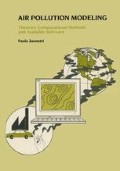Abstract
Air quality modeling is an essential tool for most air pollution studies. Models can be divided into
-
physical models — small scale, laboratory representations of the phenomena (e.g., wind tunnel, water tank)
-
mathematical models — a set of analytical/numerical algorithms that describe the physical and chemical aspects of the problem
Access this chapter
Tax calculation will be finalised at checkout
Purchases are for personal use only
Preview
Unable to display preview. Download preview PDF.
References
Alessio, S., L. Briatore, G. Elisei, and A. Longhetto (183): A laboratory model of wake—affected stack’s emissions. Atmos. Environ., 17: 1139–1143.
Benarie, M.M. (1987): The limits of air pollution modelling. Atmos. Environ., 21:(1)1–5.
Berge, P., Y. Pomeau, and C. Vidal (1984): Order Within Chaos. New York: John Wiley.
Dana, M.T., Ed. (1979): The MAP3S precipitation chemistry network: Second periodic sum- mary report. PNL 2829, Battelle, Pacific Northwest Laboratory, Richland, Washington.
Drake, R.L. (1979): Mathematical models for atmospheric pollutants. Appendix C: Governing equations for atmospheric trace constituents and solution techniques. Electric Power Research Institute Report EA-1131, Palo Alto, California.
Dutton, J.A. (1976): The Ceaseless Wind, an Introduction to the Theory of Atmospheric Motion. New York: McGraw—Hill.
Finlayson—Pitts, B.J., and J.N. Pitts, Jr. (1986): Atmospheric Chemistry. New York: John Wiley.
Goodman, J.K., and A. Miller (1977): Mass transport across a temperature inversion. J. Geographic Res., 82: 3463.
Grebogi, C., E. Ott, and J.A. Yorke (1987): Chaos, strange attractors, and fractal basin boundaries in nonlinear dynamics. Science, 238: 632–637.
Hanna, S.R. (1989): Plume dispersion and concentration fluctuations in the atmosphere. Encyclopedia of Environmental Control Technology. Volume 2, Air Pollution Control. P.N. Cheremisinoff, Editor. Houston, Texas: Gulf Publishing Co.
Lamb, R.G. (1984): Air pollution models as descriptors of cause—effect relationships. Atmos. Environ., 18 (3): 591–606.
Lewellen, W.S., and R.I. Sykes (1983): Second—order closure model exercise for the Kincaid power plant plume. EPRI report EA-3079, Electric Power Research Institute, Palo Alto, California.
McNaughton, D.J. (1980): Initial comparison of SURE/MAP3S sulfur oxide observations with long—term regional model predictions. Atmos. Environ., 14: 55–63.
Milian, M., and Y.S. Chung (1977): Detection of a plume 400 km from the source. Atmos. Environ., 11: 939–944.
Mitsumoto, S., and H. Ueda (1983): A laboratory experiment on the dynamics of the land and sea breeze. J. Atmos. Sci., 40: 1228–1240.
Nieuwstadt, F.T., and H. van Dop, Eds. (1982): Atmospheric Turbulence and Air Pollution Modeling. Dordrecht, Holland: D. Reidel Publishing Co.
Ottar, B. (1978): An assessment of the OECD study on long—range transport of air pollutants (LRTAP). Atmos. Environ., 12: 445–454.
Pack, D.H., G.J. Ferber, J.L. Heffter, K. Telegradas, J.K. Angell, W.H. Hoecker, and L. Machta (1978): Meteorology of long—range transport. Atmos. Environ., 12: 425–444.
Perhac, R.M. (1978): Sulfate regional experiment in the northeastern U.S.: The SURE program. Atmos. Environ., 12: 641–648.
Pielke, R.A. (1984): Mesoscale Meteorological Modeling. Orlando, Florida: Academic Press.
Policastro, A.J., M. Wastag, L. Coke, R.A. Carhart, and W.E. Dunn (1986): Evaluation of short—term long—range transport models; Volume 1, Analysis, procedures and results. U.S. EPA Document EPA–450/4–86–016a.
Puttock, J.S. (1979): Turbulent diffusion from sources near obstacles with separated wakes. Part II. Concentration measurements near a circular cylinder in uniform flow. Atmos. Environ., 13: 15–22.
Reynolds, S.D., R.E. Morris, T.C. Myers, and M.—K. Liu (1984a): Evaluation of three first—order closure models - Plains site. EPRI Report EA-3078, Electric Power Research Institute, Palo Alto, California.
Reynolds, S.D., C. Seigneur, T.E. Stoeckenius, G.E. Moore, R.G. Johnson, and R.J. Londergan (1984b): Operational validation of Gaussian plume models at a plains site. EPRI Report EA-3076, Electric Power Research Institute, Palo Alto, California.
Ruff, R.E., K.C. Nitz, F.L. Ludwig, C.M. Bhumralkar, J.D. Shannon, C.M. Sheih, I.Y. Lee, R. Kumar, and D.J. McNaughton (1984): Regional air quality model assessment and evaluation. EPRI report EA-3671, Electric Power Research Institute, Palo Alto, California.
Seinfeld, J.H. (1975): Air Pollution - Physical and Chemical Fundamentals. New York: McGraw—Hill.
Seinfeld, J.H. (1986): Atmospheric Chemistry and Physics of Air Pollution. New York: John Wiley.
Willis, G.E., and J.W. Deardorff (1981): A laboratory study of dispersion from a source in the middle of the convectively mixed layer. Atmos. Environ., 15: 109–117.
Author information
Authors and Affiliations
Rights and permissions
Copyright information
© 1990 Springer Science+Business Media New York
About this chapter
Cite this chapter
Zannetti, P. (1990). The Tool — Mathematical Modeling. In: Air Pollution Modeling. Springer, Boston, MA. https://doi.org/10.1007/978-1-4757-4465-1_2
Download citation
DOI: https://doi.org/10.1007/978-1-4757-4465-1_2
Publisher Name: Springer, Boston, MA
Print ISBN: 978-1-4757-4467-5
Online ISBN: 978-1-4757-4465-1
eBook Packages: Springer Book Archive

